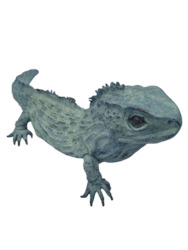Large Bronze Tuatara

THE LIVING FOSSILS - THE AOTEAROA TUATARA Tuatara are of great cultural significance to MÄori, and feature in some creation stories. Some iwi (tribes) view tuatara as the kaitiaki (guardians) of knowledge. Tuatara are among New Zealandâs most famous animals, second only to kiwi. They are representative of ancient, endemic life forms. Because tuatara still look like the fossil Sphenodontians which lived during the age of dinosaurs, 220 million years ago, they are often called living fossils. Many anatomical features distinguish them from other living reptiles â for example, they have a defining pattern of openings in the skull and a unique type of haemoglobin in the blood, and males have no external reproductive organ. The male courts the female by approaching her with a proud walk. He mounts the female, positioning her with his hind legs and tail to align their reproductive openings for the transferral of sperm. Tuatara mate in late summer. The female usually lays 6â10 eggs the following spring, in a shallow nest in the ground. She may guard the nest for a few nights, then return to her own burrow. The eggs incubate for about a year, so hatchlings emerge when eggs are being laid the following season. The hatchlings receive no parental care and have to fend for themselves. Male tuatara mate annually, while females do so only once every two to seven years, depending on the availability and quality of food. Like many other New Zealand animals, tuatara live for a long time. They reach reproductive maturity at about 15 years, and may breed for many decades. Their maximum lifespan is not known for certain, but some tuatara have reached 80 years, still looking vigorous and healthy. They may live to 100 years or more. Tuatara used to live throughout the country, but the rats introduced by humans have killed them on the mainland â they now live only on 37 offshore islands. Stephens Island (Takapourewa), in Cook Strait, has the largest tuatara population â about 30,000. Most tuatara islands have been freed of rats. Tuatara eggs are collected, and the young hatch in captivity. They are then released in sanctuaries, such as the Karori Wildlife Sanctuary in Wellington. (copied for New Zealand's hidden history & pre history)
Artist: Tuhina Hamuera
Artist: Tuhina Hamuera
Length: 600mm
Weight: 6kgs
Process: Hot cast bronze
Limited edition: 3 of 25
Please get in touch if you have any questions
- Store:
- Kiwi Artists Online
- Price:
- $6,000
×
